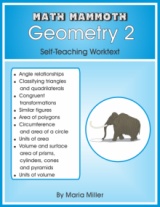Recently I've received several questions about abacus usage within Math Mammoth curriculum. Here is what I wrote and added to my FAQ on the site.
The only way the abacus is used in my books is where each bead counts as one. Nothing fancy. It is NOT used like Chinese, Russian, or any of the other abaci where one bead might count as 5, 10, or 100.
A 100-bead abacus or school abacus simply contains 10 beads on 10 rods, a total of 100. In the school abacus, each bead simply represents one. The 100-bead abacus lets children both "see" the numbers and use their touch while making them.
First and foremost, the abacus is used in the place value section in 1st grade where children learn about tens and ones (numbers up to 100). We use it to show clearly how 45 is made up of 4 tens and 5 ones, for example.
Secondly, you can use the abacus with addition and subtraction problems in 1st and 2nd grades. For example:
- Show the child additions and subtractions with whole tens. For example, to solve 50 + 20, first make 50 on the abacus. Then add 20 more.
- Add a two-digit number and a single-digit number. For example, to solve 23 + 5, first make 23 on the abacus. Then add five beads.
- Show some "shortcuts" in addition or subtraction. For example, to solve 34 + 20, first make 34 on the abacus. To add 20, add two whole rows of beads. Then the student checks how many whole tens and how many individual beads is the total.
Or, to solve 85 − 20, first make 85. Then pull back two whole rows of beads.
Or, to add 23 + 44. First make 23. Then make 44 on using the five lowest rows of the abacus. Have the child now count the whole tens (6), and the individual beads from the two rows (3 + 4). This shows adding the tens separately, and adding the ones separately. From this you can graduate to making first 23, then adding 4 full rows of beads for 40, and then adding 4 individual beads from the same row as the 3 beads.
The purpose is mainly to help children to visualize two-digit numbers, and to add and subtract two-digit numbers.
The goal in my books is to drop the abacus by 3rd grade. Even before that, students use visual models, and from those go on to the abstract. The quicker the child can use visual models, and then do the math problems without any models, the better.
At Amazon you can find
Melissa & Doug Classic Wooden Abacus for around $12.
An abacus where the beads alternate colors by fives is even more useful (but may be out of stock).
Browse
Amazon's abacus selection here
. Other stores carry abaci as well.
You can also use this
virtual abacus. Or,
make your own abacus. Just don't make it exactly like they show on that web page but instead use 10 bamboo skewer with 10 beads in each so you get a 10 x 10 abacus.
 Recently I offered one of my customers a free book for finding an error in the answer key... she declined and wished someone else could have it who is in need.
Recently I offered one of my customers a free book for finding an error in the answer key... she declined and wished someone else could have it who is in need.

